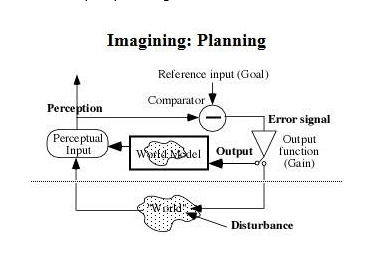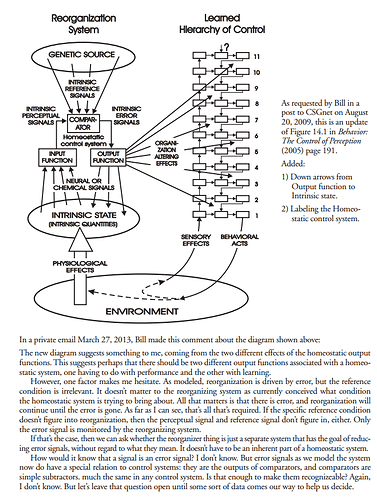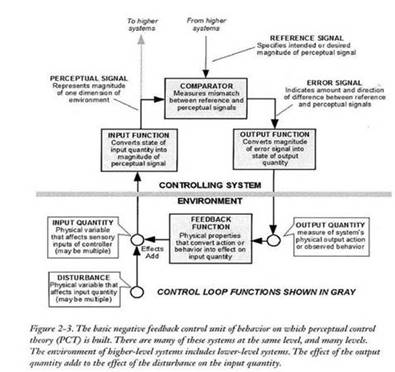it seems that you are jamed between PCT and RCT again. I don’t understand why you change your mind so often. Almost every year we have such conversation. Last was in october 2017.
This time you don’t argue your decission. There are mostly questions. I suppose you want me to answer on them. I will if you’ll specifically aks me to do it. But I think that you know the asnwers. So I 'll focus just on those theoretical problems you have about credibility of PCT.
···
From: Martin Taylor (mmt-csg@mmtaylor.net via csgnet Mailing List) csgnet@lists.illinois.edu
Sent: Friday, September 28, 2018 10:37 PM
To: csgnet@lists.illinois.edu
Subject: Re: When Control Systems Collide
[Martin Taylor 2018.09.28.16.12]
Boris, I did suggest to you that you think of Fred’s audience, did I not?
Martin, you did. And still I think that no matter to which audience we are presenting PCT it should be presented as “general theory about organism functioning”… That’s the essence of PCT. You signed for it. So I think that PCT should be presented in it’s original form.
Bill P. at all (50th Anniversary, 2011) :
Perceptual Control Theory (PCT) provides a general theory of functioning for organisms
HB : So I think it’s fair that at least Bills original diagram should be presented so that anybody can distinguish PCT from other theories. Some of theories are presenting quite the same diagram Fred used. If personal diagrams are used, it means at least for me, that whoever is using different personal diagram is presenting some other theory, his personal theory. I think I made my point clear that PCT should be presented in it’s original form, otherwise transformations can turn PCT into bunch of “pesronal viewpoints” which will not show anymore PCT but something else like in Ricks’ case (RCT).
MT : That should have been all I needed to say, but apparently it was not. So forget Bill’s diagrams for a moment, and think about what actually happens in a simple control loop.
HB : We can’t forget Bills’ diagram as it is essential part of his theory. By presenting other diagram other theory is presented. What actually happens in control loop of any Living being is clear and quite well presented in Bills’ diagram.
MT : You don’t like to see “controlled variable” in the environment, and technically you are correct.
HB : I’m not just technically correct but also practically. We can use Bills’ diagram in any life situation, it’s general. And that is not the case with other theories and diagrams. They fail in certain life situations like Ricks’ and Freds’ diagram. You can test them any time. They fail. The reality is final arbiter whether something works or not. We can change the reality to match the theory or we can change the theory to match reality. What is going to be in the case of Freds’ (Ricks’) diagram ?
Any Bills’ diagram don’t show “controlled variable” in the environment, with some reason. Bills’ PCT diagram shows general theory about how LCS function. And that means that we can explain any behavior of any LCS. With other diagrams and theories we can’t. I see that you noticed that with Fred diagram we can’t explain many behaviors. So it’s wrong in general sense.
MT : But when the perception of that environmental variable is controlled, what happens to the environmental variable?
HB : You mean what happens to the “environmental variable” in some cases of behavior ? I don’t know which case you have in mind. Maybe you meant some cases where “environmental variable” is affectd by output of the system ? Tell me which life case you have in mind ?
What happens generally with “environmental variable” is described with Bills’ diagram and definitions (see bellow). What do you think it happens ? If you have some other theory please expose it ?
PCT is clearly explaining what happens to “environmental variable” when perception is controlled. I exposed that for so many times maybe 50x.
PCT Definitions of control loop :
Bill P (B:CP):
- CONTROL : Achievement and maintenance of a preselected state in the controlling system, through actions on the environment that also cancel the effects of disturbances.
Bill P (B:CP):
- OUTPUT FUNCTION : The portion of a system that converts the magnitude or state of a signal inside the system into a corresponding set of effects on the immediate environment of the system
Bill P (LCS III):…the output function shown in it’s own box represents the means this system has for causing changes in it’s environment.
Bill P (LCS III):
- FEED-BACK FUNCTION : The box represents the set of physical laws, properties, arrangements, linkages, by which the action of this system feeds-back to affect its own input, the controlled variable. That’s what feed-back means : it’s an effect of a system’s output on it’s own input.
Bill P (B:CP) :
- INPUT FUNCTION : The portion of a system that receives signals or stimuli from outside the system, and generates a perceptual signal that is some function of the received signals or stimuli.
Bill P (B:CP) :
- COMPARATOR : The portion of control system that computes the magnitude and direction of mismatch between perceptual and reference signal.
Bill P (B:CP)
- ERROR : The discrepancy between a perceptual signal and a reference signal, which drives a control system’s output function. The discrepancy between a controlled quantity and it’s present reference level, which causes observable behavior.
Bill P (B:CP) :
- ERROR SIGNAL : A signal indicating the magnitude and direction of error.
![cid:image001.jpg@01D37ABE.36063DF0]()
MT : By the way, I think I am in agreement with Bill in saying that PCT as written by him in publications and on CSGnet is not a cast-in-stone theory, and neither is it a gospel to be believed in its entirety or risk being labelled a heretic. I, and I believe he, considered it a good working skeleton on which to build by finding out how living organisms function. No more, no less.
HB : You are twisting his thoughts turning it into what you think they should sound. That’s probably what every LCS would do. There is more. He also said that nature is the final arbiter. So I think that with skeleton he meant work that was done and it is plausable with “final arbiter”. So every addition that could built findings about how organisms function should be also in accordance to that. So Ricks and Freds’ diagram simply do not meet that criterium. They don’t work in reality just in their imagination.
MT : To deviate from the written word (or diagram) is not necessarily to believe some other gospel, if the deviation is to show other possibilities for extending the reach of the theory or to explain phenomena poorly handled by the skeletal original.
HB : As I said above Martin. It can deviate from PCT diagram but not in the sense that whatever you, Fred or Rick say is true and it should be suplement to the original theory. First you have to prove that it works in “final arbiter”. And beside that I think when “deviation” is pure opposition to original theory it should be considered as other theory like RCT (Ricks’ Control Theory) is.
MT : It’s just the progress of science. If there are other ways of doing something, and no data that favours one over another, they should all be kept open as possibilities.
HB : As I wrote before. I have no objection about scientific progress in PCT. But it should be scientific not phylosophic. Whatever we are doing now is phylosophy. We need some arguments and plausability with “final arbiter”.
Martin. Bill made a great basis (skeleton) for developing theory which is unique in the world of science so I think it’s never enough of efforts to develope it. I proposed many times that upgrade to PCT is needed. And it seems that Rupert and you agree… and probably some other members. I agree with your last statements about PCT being a "good working skeleton on which to build by finding out how living organisms function. " But every good working skeleton has to be “tested” in real life situations. That was also Bills’ mantra. Reality is the final arbiter. So before you wave with the "flag"of saying that PCT as written by him in publications and on CSGnet is not a cast-in-stone theory, it’s good if we check PCT and your theory or findings about how organisms function in the “final arbiter”. Freds’ and Ricks’ model of human behavior generally does not function in real life. You said for yourself I’m theoretically right about “controlled variable” not being in external environment. And I’m saying that I’m not just theoretically right, but also practically. Beside what Bill proved about PCT and what I experienced and I’m still experiencing he was generally right. I just control perception. Anybody can “test” that.
If you can find better theory make yourself comfortable and show us how does it look like and show how it works in “final arbiter”. Freds’ diagram does not work with many behaviors, so show us how your theory works with all behaviors. Does it work or not.
Remember Rayleigh and Jeans catastrophe in Physics. Mostly it worked right. That’s not enough for “final arbiter”. Physics standards are too high. If I remember right it was Planck who solved the problem and adjusted right theory to reality not vica verse. How could we adjust reality to Rayleigh and Jeans theory ?
I’m quite sure you will agree with Planck. But in physics theory has to be adjusted to “final arbiter” and in PCT anybody can change a theory. He just has to have 5 minutes time. I think that for all theories no matter whether it is in physicis or in psychology it has to be the same criterium.
MT : As for your other questions in this and your parallel email about the use of the World Model, I do not think they are relevant to the operations of a single simple control loop, which is what Fred tries to get across to his readers.
HB : Diagram in parallel post is showing a good Bills’ trial to analyse the whole organisms functioning which important part is also “single control loop” Fred wanted to present. If you want to understand how “single control loop” function (look carefully where it is situated in the whole diagram) you have to understand how organisms in the whole function. And you’ll understand why there is no “controlled variable” in environment. PCT is general theory about organisms functioning not just part of it. And I’m proposing for years that we should make a huge project which will finnish what Bill started. To get some general order in bilions of signals present in nervous system. It seems that Powers ladies don’t want that.
![cid:image001.png@01D119FD.595FDCD0]()
Boris
On 2018/09/28 12:48 PM, “Boris Hartman” (boris.hartman@masicom.net via csgnet Mailing List) wrote:
Martin,
If you don’t want to recall what I wrote to Fred, to you and others about diagram with “controlled variable” outside, you will not. I could think that you play “ignorancy”. Anyway and human LCS can play whatever he wants. I can’t control you although Rick thought I can.
But I hoped that in this 5 years since Rick started to turn PCT into RCT, you and some others remembered and learned something about PCT. It seems that you didn’t.
O.K. explain with Fred’s diagram generally how organisms function ? Using Fred’s diagram explain how E.colli function, explain sleeping, explain observing behavior. Explain what is happening when you are sunshinning, when you are sitting and thinking, etc. Explain to us how with Fred diagram “canonical principle” in control loop function ? That’s what you were talking about when you changed your mind about PCT (october 2017).
Boris
From: Martin Taylor (mmt-csg@mmtaylor.net via csgnet Mailing List) csgnet@lists.illinois.edu
Sent: Friday, September 28, 2018 3:40 PM
To: csgnet@lists.illinois.edu
Subject: Re: When Control Systems Collide
[Martin Taylor 2018
to [Boris, undated and without identifier]
I guess if you don’t want to answer what is wrong with Fred’s diagram, you won’t.
Martin,
you must be kidding. I’ve exposed problem for I don’t know how many times on CSGnet. So will you please search archives to see my answer. I discussed it with you clearly when you tryed to change your mind about PCT. Remember ? It was arround october 2017 when you seriously thought about changing your mind to RCT.
But I was asking myself if you ever elaborated your old diagram ?
![mailbox:///Users/mmt/Documents/Thunderbird_data/Mail/mmt-csg/Inbox?number=299402336&header=quotebody&part=1.2&filename=image001.png]()
I don’t use it in that form as a rule, but I guess it still serves if anyone else wanted to use it.
Martin
Boris
From: Martin Taylor (mmt-csg@mmtaylor.net via csgnet Mailing List) csgnet@lists.illinois.edu
Sent: Thursday, September 27, 2018 8:50 PM
To: csgnet@lists.illinois.edu
Subject: Re: When Control Systems Collide
[Martin Taylor 2018.09.27.14.47]
On 2018/09/27 1:35 PM, “Boris Hartman” (boris.hartman@masicom.net via csgnet Mailing List) wrote:
Fred,
we probably all read your paper. I didn’t want to answer as I expressed so many times attitude to diagrams which were not in accordance with Bills’. Why didn’t you use one of diagrams from Bills’ literature ? For example diagram in LCS III ?
What do you find wrong with Fred’s diagram, knowing who he is writing for? In what way do you see it as not being in accordance with Bill’s?
Martin
Best,
Boris
From: Fred Nickols (fwnickols@gmail.com via csgnet Mailing List) csgnet@lists.illinois.edu
Sent: Thursday, September 27, 2018 7:02 PM
To: mmt-csg@mmtaylor.net
Cc: csgnet@lists.illinois.edu
Subject: Re: When Control Systems Collide
From Fred Nickols (2018.09.27.1300 ET)
Has anyone besides Martin read the paper I posted?
On Sat, Sep 22, 2018 at 4:03 PM Fred Nickols fwnickols@gmail.com wrote:
Fred Nickols (2018.09.22.1602 ET)
Many thanks, Martin. Your changes make sense and I will incorporate them.
On Sat, Sep 22, 2018 at 1:08 PM Martin Taylor csgnet@lists.illinois.edu wrote:
[Martin Taylor 2018.09.22.12.50]
Fred Nickols (2018.09.22.1228 ET)
I’ve started working on a new Knowledge Worker column with the title in the subject line of this message (see the attachment). I’d be very interested in comments and suggestions from people on this list.
Fred, I like it very much. I might suggest two minor edits, in the first lines of the second and third paragraphs. Both come from the same background thought, that there are at leat 16 different ways in which two control loops can interact (collide).
Para 2, I would say “there is usually” rather than simple “there is”, because occasional collisions can be mutually beneficial. (Those are the ones on which society and organizations are built).
Para3. I would substitute for “because” the following or some variant thereof: “in a variety of ways, but most often”.
A nit-pick. In the first para, do you think that “the non-human kind” examples are living control systems, or any kind of control systems? I don’t. I think they set up what Powers called contingencies, in that they affect the probable results of different kinds of action by the living control systems, because of the disturbances those actions might cause to perceptions controlled by others. Bill’s example of the different kinds of contingencies of driving too fast through Durango include smashing the car (laws of nature) and getting a speeding ticket (rules and regulations). My preference would be to eliminate everything from the dash to the end of the sentence, unless there is some other point you want to make about rules, such as that they are (usually collectively) controlled variables that the other individual (e;g; Joe) is trying to change, in which case maybe as a second sentence if para 3 would be the place to mention them. But this is just a nit of a kind that is rather easy to pick.
Martin
–
Fred Nickols
Distance Consulting LLC
“Assistance at A Distance”
www.nickols.us
–
Fred Nickols
Distance Consulting LLC
“Assistance at A Distance”
www.nickols.us


